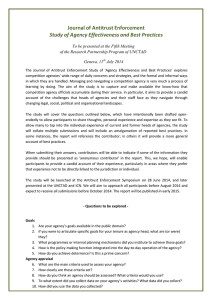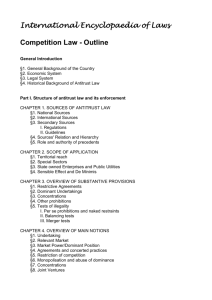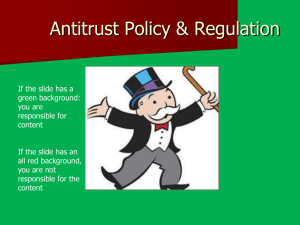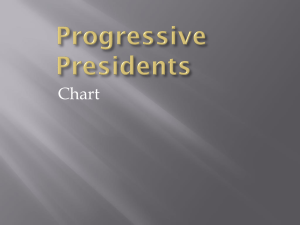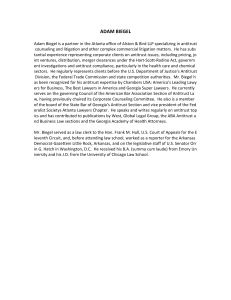Bespoke Competition Policy for Developing Countries
advertisement
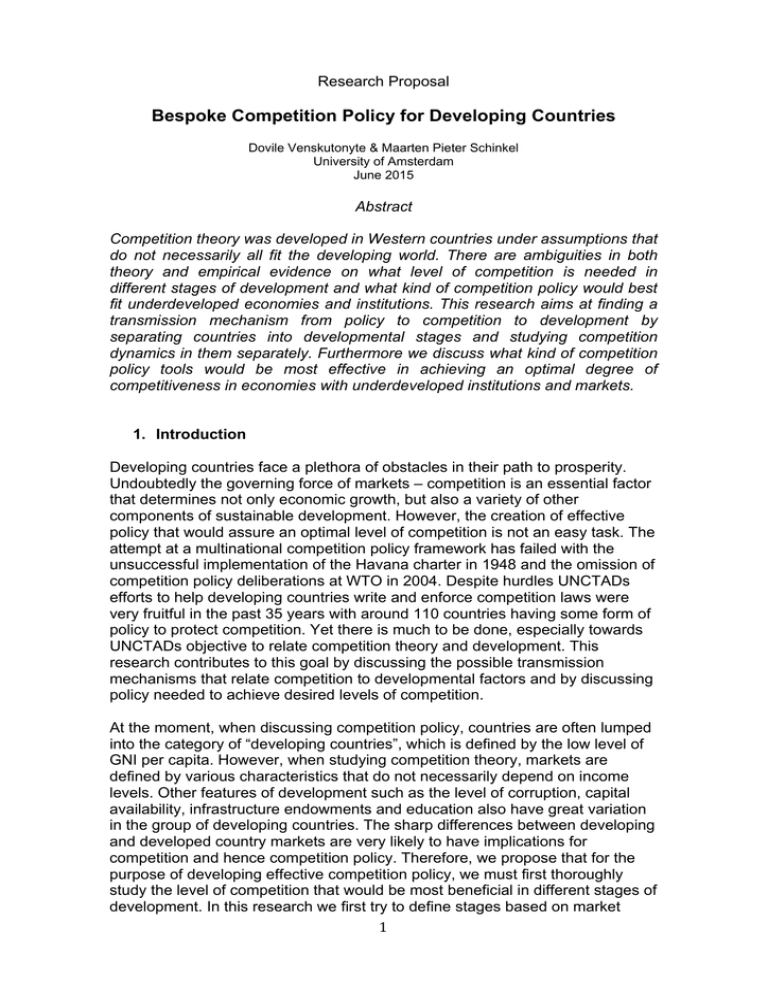
Research Proposal Bespoke Competition Policy for Developing Countries Dovile Venskutonyte & Maarten Pieter Schinkel University of Amsterdam June 2015 Abstract Competition theory was developed in Western countries under assumptions that do not necessarily all fit the developing world. There are ambiguities in both theory and empirical evidence on what level of competition is needed in different stages of development and what kind of competition policy would best fit underdeveloped economies and institutions. This research aims at finding a transmission mechanism from policy to competition to development by separating countries into developmental stages and studying competition dynamics in them separately. Furthermore we discuss what kind of competition policy tools would be most effective in achieving an optimal degree of competitiveness in economies with underdeveloped institutions and markets. 1. Introduction Developing countries face a plethora of obstacles in their path to prosperity. Undoubtedly the governing force of markets – competition is an essential factor that determines not only economic growth, but also a variety of other components of sustainable development. However, the creation of effective policy that would assure an optimal level of competition is not an easy task. The attempt at a multinational competition policy framework has failed with the unsuccessful implementation of the Havana charter in 1948 and the omission of competition policy deliberations at WTO in 2004. Despite hurdles UNCTADs efforts to help developing countries write and enforce competition laws were very fruitful in the past 35 years with around 110 countries having some form of policy to protect competition. Yet there is much to be done, especially towards UNCTADs objective to relate competition theory and development. This research contributes to this goal by discussing the possible transmission mechanisms that relate competition to developmental factors and by discussing policy needed to achieve desired levels of competition. At the moment, when discussing competition policy, countries are often lumped into the category of “developing countries”, which is defined by the low level of GNI per capita. However, when studying competition theory, markets are defined by various characteristics that do not necessarily depend on income levels. Other features of development such as the level of corruption, capital availability, infrastructure endowments and education also have great variation in the group of developing countries. The sharp differences between developing and developed country markets are very likely to have implications for competition and hence competition policy. Therefore, we propose that for the purpose of developing effective competition policy, we must first thoroughly study the level of competition that would be most beneficial in different stages of development. In this research we first try to define stages based on market 1 characteristics and apply competition theory in order to gain insight into what market structure and policy would be most favorable to development. Secondly, we will develop a framework for measuring competition policy and deciding the laws and enforcement tools that are optimal in separate developmental stages. 2. Background Theory tells us that the benefits of competition are abundant. Under standard assumptions firms in competitive markets are forced to price at low margins, market shares are allocated to the most efficient and low cost players and new entrants grow the market. This should result in an innovative, efficient and growing economy, where consumer surplus is maximized and the entire population prospers. There is evidence that anticompetitive practices harm developing countries to a great extent, especially the poorest citizens. Poor law enforcement and detection abilities often result in hard-core cartels and abuse of dominance (van Bergeijk, 2009). Even in South Africa, which unlike other developing countries has an exceptionally active competition authority, markups are much higher in certain markets, compared to their counterparts in developed countries (Aghion, 2008). A review of cartels and collusion cases in developing countries by Jenny (2006) shows the staggering effects anticompetitive practices have on both producers and consumers, with prices being inflated up to 25-30%. Small firms are harmed by buyer cartels charging too low prices for their products as well as by upstream suppliers colluding to inflate the prices of inputs. Consumers suffer from price fixing agreements as well, especially in basic goods like bread, flour and sugar. Due to very low incomes in many developing countries food price surcharges are particularly damaging. Furthermore, there is evidence to suggest that high market concentration leads to lower employment, which is a crucial problem in developing countries (Fedderke, 2008). Considering that these economies are very vulnerable, competition infringements result not only in welfare loses, but also in the stifling of development and impoverishment (Fox, 2012). The list of cases where effective protection of competition would have been beneficial is long, however we should not assume that intense competition is always the right answer, especially in the developing world. The theory we have now was reasoned on the basis of developed country experiences, with assumptions like the availability of capital markets, low entry barriers and low transaction costs, which are simply not good approximations of markets in developing countries. The effect of competition is not clear and depends on a variety of factors; therefore we should reconsider how and to what extent existing theory applies in underdeveloped economies (Aghion, Griffith, 2008). There is a clear consensus in the literature that relates competition and growth, that growth requires increases in productivity, which is achieved through investment in innovation. Therefore one of the most important questions to ask in this discussion is what is the effect of competition on innovation. The two main competing theories are those of Arrow and Schumpeter. In essence, Arrow believes that competition stimulates innovation, because firms that do not innovate will go out of business and so the need to innovate is higher under competition than under concentration, where a monopoly or oligopolies will likely stay in the game even without R&D investments. Some empirical evidence supports Arrows view, however there is evidence for the 2 Schumpeterian effect as well. He argued that in order for firms to have enough incentive to make innovation investments, there need to be high potential profits, which cannot be achieved under strong competition and so market concentration can improve growth though innovation (Baker, 2007). Latest theory and evidence seems to suggest that there is an inverted U-shape relationship between innovation and competition. Meaning that starting from a very concentrated market, new entrants will increase competition and the incentives to innovate, however at some point this effect will reverse and more competitors will erode potential profits from innovation, which will decrease investments (Aghion 2002, Onori 2014 ). Clarke (2011) investigates the effects of competition policy on competition and its effects on innovation in a sample of East European and Central Asian Economies, he finds that competition policy pressures companies to innovate, but also reduces profits from innovation and the net effect is ambiguous. His research suggests that competition policy induces new product development, but not process innovation. Considering that process innovation is mostly needed in least developed countries, these findings should be considered further, since they may well indicate an argument against competition in early stages of development. Most recently Àlvarez and Campusano (2014) carried out empirical research on the impact of competition on innovation in 70 developing countries. Using the Boone index to measure competition and industry level non-patent innovation data from the World Bank Investment Climate Survey, they find that competition intensity significantly reduces the probability of innovation for both product and process innovation, low and high tech industries and for across the Pavitt taxonomy of industry types. Furthermore, contrary to the inverted U-shape relationship hypothesis, they find that the negative effect of competition is monotonic and does not depend on the initial level of competition. The authors attribute this effect to the low levels of innovation appropriability in developing countries. On the other hand, concentration is likely to lead to higher prices and hence more spending and less savings. Besides the direct negative effect this has on consumers, there is also evidence to suggest that lower domestic savings leads to less productivity growth and less FDI inflows (Aghion, 2006). A similar principle should apply to the level of both foreign and domestic investment in a country. Considering that entry barriers are very high, especially in early stages of development setting up new business and expanding it requires large fixed cost and it is not clear whether intense competition would stimulate investment. Singelton (1997) has argued that governments of developing economies would adopt a competition policy to stimulate entry and alleviate barriers as much as possible. Not only for the straight forward reason, but also because this approach is less prone to corruption. Others have argued for the importance of generating rather than protecting competition, through ensuring fairness, providing guidance and fostering acceptance of a culture of competition in the market and population at large. In some cases, it is thought that efficiency can be sacrificed to a small extent for this purpose (Budzinzki & Beigi in Drexl et al. 2015, pages 223-247). From a policy perspective the effect of competition policy on FDI can be twofold as well. On the one hand, if there is no antitrust law or if it is not enforced, the likely price increases due to cartel behavior would attract foreign companies able to charge lower prices. On the other hand, domestic companies may have been successful in building barriers to entry that would create disincentives for foreign competitors (Evenett, 2003). 3 There is some empirical evidence to suggest that competition policy and its enforcement increases FDI (Clarke, 2003), however it is also not clear whether the effect of foreign competitors is positive since they may prevent the establishment of domestic industries. Perhaps only monopoly or oligopoly profits are motivating enough for firms to pursue new ventures (Singh, 2007). After all, development success stories such as China, Singapore, Hong Kong or India achieved high growth rates without competition policy. In fact China first introduced some basic antitrust and abuse of dominance laws only in 2008. Furthermore, other examples of extremely fast development Japan and South Korea discouraged FDI in order to grow huge domestic conglomerates (Amsden, Sigh, 1994). In Latin America agricultural clusters and cooperation between farmers have proven to be effective, which again goes against the hypothesis that competition will lead to growth (Altenburg, 1998). 3. Testing the Effectiveness of Competition Policy Even though there is no theoretical mechanism of how policy will lead to growth there is a number of studies, which test various measures of competition policy on growth and productivity. Early work of Dutz and Hayri (1999) finds a positive effect on growth of both competition and antitrust legislation in all countries but the Asian Tigers. Later Dutz and Vagliasindi (2000) use a more sophisticated competition policy survey data set in addition to institutional development indexes to study Easter European countries after the fall of the Iron Curtain and find a positive but weak effect on growth, less significant than the effect of general institutional health, transparency and efficiency. Krakowski (2005) finds a positive effect of competition policy on growth that increases with the experience of the competition authority. Voight (2009) develops an index describing the formal competition laws, the degree to which they have an economic foundation and the de facto and de jure independence of the competition authority and finds a weak effect on Total Factor Productivity growth. Ma (2011) has done some of the most sophisticated research of this kind on data from developing countries. He uses an antitrust law and antitrust enforcement indexes constructed by previous researchers and tests their effect on growth through the Solow model. He divides countries into a “rich” and a “poor” group, based on an index that “measures the extent to which people have confidence in and abide by the rules of society” and looks at them separately. Ma finds that the enforcement but not the law index has a significant positive effect. However, the effect only holds for the “rich” and not the “poor” group of countries. Nicholson (2008) developed an index of competition policy that included all types of antitrust law and had a relatively broad scope. However, the author does not find a strong effect of the index on competition and recommends looking into the theoretical relationship of policy and competition. Deng and Hylton (2006) build on the methodology of Nicholson and construct their own policy index covering the main areas of antitrust, but ignoring the more detailed differences between different jurisdictions. The authors acknowledge that this is a problem, but find a significant positive effect of their index on the perceived intensity of competition, which is measured by survey data. 4 This research even though very valuable is not sufficient, especially because the methodology for policy indexes is likely to not be very representative of the actual health of competition policy in developing countries. Some include only the very basic aspects of policy and do not combine them with enforcement capabilities. Furthermore Borell and Toloso (2008) argue that there is an endogeneity problem in previous research, because antitrust policy is affected by productivity and growth, with more productive countries being more likely to create antitrust policy. Also other government activities have a two-way relationship with competition policy and that can cause estimation biases. For example competition and trade policies are almost substitutes for one another. Waked (2010) argues that development and macroeconomic indicators affect the implementation success of antitrust policy. She makes an insight that most developing countries are committed to antitrust enforcement in terms of budget allocated to competition authorities and staff, however this does not guarantee enforcement in practice. Therefore there is much room for improvement in this area. 4. Research Objectives The goal of this research is to identify a transmission mechanism from competition policy to competition to development. If successful we will be able to use this framework to draw policy recommendations for developing countries. To achieve this goal we will separate the research process into stages as follows. 1st stage: Identify stages of development, development objectives and a measurement of competition policy. a) What are distinguishing features of stages of development relevant for competition policy? Because developing countries are a highly heterogeneous group ranging from EU members to resource rich countries to the most impoverished states, we need to classify them into representative stages of development based on factors that influence competition directly. Various scholars have discussed these factors to different extents. A recent book on the characteristics of countries that affect competition discusses some economic indicators such as the sectorial composition of output, barriers to entry, informal economy and composition of spending (Evenett in Drexl et al. 2015, pages 15-30), as well as cultural aspects such as the outlook on competition and gender equality. There are several indicators of development that concentrate on income and GDP, but are not representative of the relevant factors that influence competition (Indig & Gal in Drexl et al. 2015, pages 51-82). Beginning with Rostow (1959), scholars have identified stages in development of a country. Currently the World Economic Forum identifies 3 stages with 2 transition categories used to calculate their Global Competitiveness index. They are based on GDP per capita and the share of natural resources in the export sector (Shwab, 2014). We think that this is a good basis, however we will expand it to include factors such as the importance of the agricultural sector, economic diversification, infrastructure and others. 5 b) What are developmental objectives for different stages, relevant to competition policy? We will review literature of developmental economics as well as various reports done by international organizations and government agencies to identify the factors most important for development relevant to competition such as innovation, demand building, investment and others. It is important to identify the objectives, which are most influenced by competition intensity, so that we could establish priorities and identify the tradeoffs competition will have on them. c) What is a scale of sophistication and complexity for competition policy laws and tools? We will develop a neutral, meaning not immediately related to particular countries, scale of antitrust laws and enforcement tools. Individual aspects of competition policy and the extent to which they would benefit a competition authority with limited resources and experience have been discussed to varying degrees. For example some have argued that less economic analysis may be appropriate (Gerber in Drexl et al. 2015, pages 248-264), while others discuss the tradeoffs of leniency programs (UNCTAD, 2010). However, at the moment the research is sporadic. We believe that it is possible to combine different parts of competition policy and develop a scale of toolkits that varies in scope and complexity. 2nd Stage: Explain how competition dynamics affect developmental objectives at different stages of development. a) Firstly we will describe each stage of development on the basis of its more specific market characteristics, such as degree of product differentiation, type of innovation needed, degree of foreign competition, demand elasticity and others. b) Secondly we will apply existing theory to identify the likely effects of competition on market performance and developmental objectives. c) Thirdly we will identify the tradeoffs of competition and areas where the benefits of competition are ambiguous. 3rd Stage: Developing a framework for competition policy effectiveness. a) Firstly we will develop a scale of competition policy laws and enforcement tools ranging from least sophisticated to most. b) Secondly we will discuss what level of competition policy and tools are needed to achieve the desired degree of competition at a given stage of development, assuming ideal institutional conditions. c) Thirdly we will discuss what competition policy would be optimal taking into account the different degrees of corruption and institutional health. 6 d) Fourthly we will discuss and develop a framework for analyzing the benefits of competition policy relative to other factors affecting competition, such as natural barriers to entry, regulatory burden and the state of other regulations. 4th Stage: Conclusion If this research is successful we should see a pattern of changes in competition intensity needed and the optimal scope of competition policy with respect to changes in a countries development. Speaking in extreme terms, the conclusion could well be that all countries should always try to protect competition or that it is not possible to group countries into developmental stages for the purpose of analyzing competition and that policy should be designed from top to bottom for each given state or even industrial sector. 5. Conclusion In order to design and implement effective competition policy that will be valuable for developing countries, we must first study the goals it should be aimed at. Today the relationship between growth and competition is unclear and likely to be specific for different groups of countries. Therefor we have proposed to study the application of competition theory in separate stages of development. We also think that it would be greatly beneficial to consider policy that would best achieve the goals of developing countries given the realities of their economies and institutions. Lastly, we think it is important to test the relative importance of competition policy to other factors in order to allocate resources to the most efficient solution for competition problems in the developing world. The relationship between competition policy and development is quite complex, because, as previous research has shown, competition has both negative and positive effects that influence development through different channels. It is true for policy as well: different laws may be important for fair competition and have potential for abuse. Research and discussion so far has been very valuable, yet there is a great literature of economic theory that has not yet been extensively applied to developing economies. This research lays down a foundation for discussing not only the effects of policy but more importantly competition itself, emphasizing the ambiguity of the relationship between competition and development and attempting to disentangle and clarify. References: Aghion, P., Bloom, N., Blundell, R., Griffith, R., & Howitt, P. (2002). Competition and innovation: An inverted U relationship (No. w9269). National Bureau of Economic Research. Aghion, P., Braun, M., & Fedderke, J. (2008). Competition and productivity growth in South Africa. Economics of Transition, 16(4), 741-768. Aghion, P., Comin, D., & Howitt, P. (2006). When does domestic saving matter for economic growth? (No. w12275). National Bureau of Economic Research. 7 Aghion, P., & Griffith, R. (2008). Competition and growth: reconciling theory and evidence. Altenburg, T., & Meyer-Stamer, J. (1999). How to promote clusters: policy experiences from Latin America. World development, 27(9), 1693-1713. Alvarez, R., & Campusano, R. (2014). Does Competition Spur Innovation in Developing Countries? (No. wp388). Amsden, A. H., & Singh, A. (1994). The optimal degree of competition and dynamic efficiency in Japan and Korea. European Economic Review, 38(3), 941-951. Baker, J. B. (2007). Beyond Schumpeter vs. Arrow: How Antitrust Fosters Innovation. Antitrust Law Journal, 575-602. van Bergeijk, P. (2010). What could anti-trust in the OECD do for development?. ISS Working Paper Series/General Series, 473, 1-19. Clarke, G. R. (2011). Competition policy and innovation in developing countries: Empirical evidence. International Journal of Economics and Finance, 3(3), p38. Drexl, J., Bakhoum, M., Fox, E. M., Gal, M., & Gerber, D. (2015). The Economic Characteristics of Developing Jurisdictions: Their Implications for Competition Law, Edward Elgar (forthcoming). Dutz, M. A., & Vagliasindi, M. (2000). Competition policy implementation in transition economies: an empirical assessment. European Economic Review, 44(4), 762-772. Evenett, S. J. (2003). Links between development and competition law in developing countries. Manuscript, Oxford University, Oxford, UK. Fedderke, J., & Szalontai, G. (2009). Industry concentration in South African manufacturing industry: Trends and consequences, 1972–96. Economic Modelling, 26(1), 241-250. Fox, E. M., & Gal, M. S. (2014). Drafting Competition Law for Developing Jurisdictions: Learning from Experience. Economic Characteristics of Developing Jurisdictions: Their Implications for Competition Law, Edward Elgar, 14-11. Fox, E. M. (2012). Competition, Development and Regional Integration: In Search of a Competition Law Fit for Developing Countries. Competition Policy and Regional Integration in Developing Countries, Josef Drexl, Mor Bakhoum, Eleanor M. Fox, Michal Gal and David Gerber, eds.(Elgar 2012), 11-04. Hayri, A., & Dutz, M. (1999). Does more intense competition lead to higher growth?. 8 Hylton, K. N., & Deng, F. (2006). Antitrust around the world: An empirical analysis of the scope of competition laws and their effects. Available at SSRN 925670. Jenny, F. (2006). Cartels and collusion in developing countries: lessons from empirical evidence. World Competition, 29(1), 109-137. Krakowski, M. (2005). Competition Policy Works: The Effect of Competition Policy on the Intensity of Competition-An International Cross-Country Comparison. Ma, T. C. (2011). The effect of competition law enforcement on economic growth. Journal of Competition Law and Economics, 7(2), 301-334. Nicholson, M. W. (2008). An antitrust law index for empirical analysis of international competition policy. Journal of Competition Law and Economics, 4(4), 1009-1029. Onori, D. (2014). Competition and growth: reinterpreting their relationship. The Manchester School. Rostow, W. W. (1959). The stages of economic growth. The Economic History Review, 12(1), 1-16. Schwab, K., & Sala-i-Martin, X. (Eds.). (2014). The global competitiveness report 2014-2015. Geneva: World Economic Forum. Singleton, R. C. (1997). Competition Policy for Developing Countries: A Long run, Entry based Approach. Contemporary Economic Policy, 15(2), 1-11. Singh, A. (2007). 12. Competition and competition policy in emerging markets: international and developmental dimensions. Growth and Economic Development: Essays in Honour of AP Thirlwall, 207. UNCTAD (2010) The use of leniency programmes as a tool for the enforcement of competition law against hardcore cartels in developing countries. Sixth United Nations Conference to Review All Aspects of the Set of Multilaterally Agreed Equitable Principles and Rules for the Control of Restrictive Business Practices Geneva, 8–12 November 2010. Voigt, S. (2009). The effects of competition policy on development–crosscountry evidence using four new indicators. Journal of Development Studies, 45(8), 1225-1248. Waked, D. I. (2010, July). Antitrust enforcement in developing countries: reasons for enforcement & non-enforcement using resource-based evidence. In 5th Annual Conference on Empirical Legal Studies Paper. 9

